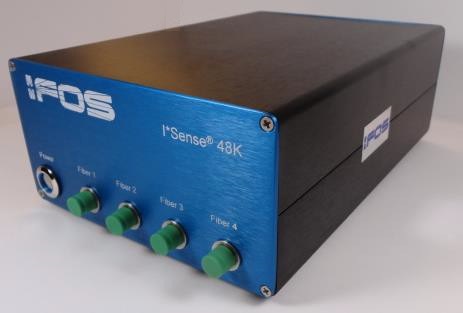| IFOS-ISense-48K-Data-Sheet-V2-2015 | |
| Number of Fibers | 4 (larger numbers optional with additional external switch module and firmware key) |
| Number of Sensors per Fiber | 8 (dependent on strain range) |
| Strain Range | ± 4000 µstrain (C+L band) |
| Detection Speed | 6 kHz per FBG |
| Resolution | 0.1 pm |
| Absolute Accuracy | +/- 2 pm |
| Dynamic Range | 50 dB |
| Maximum Reach | 100 km |
| Optical Connectors | FC and E2000 APC |
| Operating Temp. Range | 0-55º C (-10-70º C optional) |
| Optical Power | 5 to 14 dBm |
| Power SupplyVoltage | 85-240 V |
| Power Consumption | 1.2 W (Typical Operation)3.5 W (Max.) |
| Dimensions (WxDxH) | 155 x 216 x 78 mm |
| Weight | 1.36 kg (includes switch, excludes small power supply) |
| Lifetime | >25 years |
| Wavelength Range | C (Multiple bands available) |
| Interface | USB2.0 |
| Software | Windows 7, XP, C++, LabVIEW, Matlab GUI / Library |
The IFOS I*Sense™ 48K offers a cost effective, high-speed, lightweight and small footprint solution for monitoring up to 32 Fiber Bragg Grating (FBG) sensors.
Key features and benefits of the IFOS I*Sense™ are:
- Directly measures temperature, static and dynamic strain
- Can measure vibration, acoustics and acoustic emission
- Multiple sensors multiplexed on a single fiber
- High speed of up to 3 MHz for every FBG per fiber
- High resolution, accuracy, and dynamic range
- Automatic calibration
- Scalable with multiple fiber connection capabilities
- Remote monitoring system for up to 100 km
- Solid state, no moving parts
- Compact, lightweight, low power consumption
- Operates in harsh and demanding environments
- Long life and high reliability
- Integrated intelligent monitoring system
- Customizable decision aid algorithms and displays
- Fiber or wireless backhaul transmission capability
The I*Sense™ provides simultaneous data display and storage for all its channels with every FBG seeing the full bandwidth, offering high precision, remote monitoring, long life, large dynamic range, and high measurement range with multiple optical bands available for expansion. Different sensing elements can be deployed on a single optical fiber enabling a mix of strain, temperature and derivative measurements for e.g. displacement, tilt, pressure, chemical and biochemical measurements, to best meet varying customer needs at a series of discrete locations.


 LinkedIn
LinkedIn